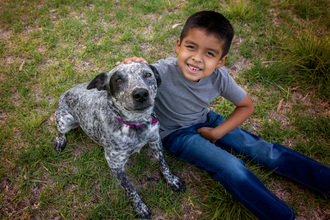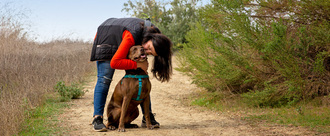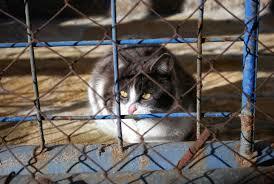-
Dígale a los oficiales de Weslaco: apoyen la programación del albergue de animales que salva vida...A veces, cuando quieres crear un cambio en tu comunidad, es difícil saber por dónde empezar. Juntos podemos hacer cambios sostenibles que salven vidas mientras creamos un marco de apoyo para las mascotas de la ciudad Weslaco y las personas que se preocupan por ellas. Los animales que terminan en el albergue de animales son parte de esta comunidad y los oficiales locales necesitan saber que usted se preocupa por toda la comunidad, , tanto como mascotas y personas. Ellos necesitan saber que usted está de acuerdo que el albergue de animales locales adopte políticas que disminuyan el número de perros y gatos sacrificados y que usted apoya la provisión de recursos necesarios para hacerlo. Algunos ejemplos de recursos incluyen programas comunitarios para gatos (para asegurar que los gatos sean castrados, vacunados y devueltos a sus hogares), programas de hogar temporal (para proporcionar alojamiento temporal a las mascotas antes de encontrar sus hogares permanentes), puntos de adopción y servicios y recursos progresivos para asegurar que la gente tenga lo que necesita para mantener a tus mascotas. Al abogar por estos programas y por la colaboración y el apoyo continuada a su albergue de animales local, usted puede formar parte de la creación de una comunidad más saludable para las mascotas y las personas. ¡Muestra tu apoyo firmando y compartiendo hoy mismo!15 of 100 Signatures
-
Tell Penitas officials: support lifesaving animal shelter programmingSometimes when you want to create change in your community, it's hard to know where to begin. Together we can make sustainable changes that save lives while creating a framework of support for the pets of Penitas and the people who care about them. Animals who end up at the animal shelter are part of this community and local officials need to know you care about the whole community- pets and people. They need to know that you prioritize the local animal shelter adopting policies that decrease the number of dogs and cats euthanized and that you support providing resources needed to do so. Some examples of resources include community cat programming (to ensure cats are spayed/neutered, vaccinated, and returned to their homes), foster programming (to provide temporary housing to pets prior to finding their permanent homes), adoption outlets, and progressive field services and resources to ensure people have what they need to keep their pets. By advocating for these programs and continued collaboration with and support of your local animal shelter, you can be part of creating a healthier community for pets and people. Show your support by signing and sharing today!36 of 100 Signatures
-
Tell San Juan officials: support lifesaving animal shelter programmingSometimes when you want to create change in your community, it's hard to know where to begin. Together we can make sustainable changes that save lives while creating a framework of support for the pets of San Juan and the people who care about them. Animals who end up at the animal shelter are part of this community and local officials need to know you care about the whole community- pets and people. They need to know that you prioritize the local animal shelter adopting policies that decrease the number of dogs and cats euthanized and that you support providing resources needed to do so. Some examples of resources include community cat programming (to ensure cats are spayed/neutered, vaccinated, and returned to their homes), foster programming (to provide temporary housing to pets prior to finding their permanent homes), adoption outlets, and progressive field services and resources to ensure people have what they need to keep their pets. By advocating for these programs and continued collaboration with and support of your local animal shelter, you can be part of creating a healthier community for pets and people. Show your support by signing and sharing today!36 of 100 Signatures
-
Tell La Villa officials: support lifesaving animal shelter programmingSometimes when you want to create change in your community, it's hard to know where to begin. Together we can make sustainable changes that save lives while creating a framework of support for the pets of La Villa and the people who care about them. Animals who end up at the animal shelter are part of this community and local officials need to know you care about the whole community- pets and people. They need to know that you prioritize the local animal shelter adopting policies that decrease the number of dogs and cats euthanized and that you support providing resources needed to do so. Some examples of resources include community cat programming (to ensure cats are spayed/neutered, vaccinated, and returned to their homes), foster programming (to provide temporary housing to pets prior to finding their permanent homes), adoption outlets, and progressive field services and resources to ensure people have what they need to keep their pets. By advocating for these programs and continued collaboration with and support of your local animal shelter, you can be part of creating a healthier community for pets and people. Show your support by signing and sharing today!30 of 100 Signatures
-
Tell Alamo officials: support lifesaving animal shelter programmingSometimes when you want to create change in your community, it's hard to know where to begin. Together we can make sustainable changes that save lives while creating a framework of support for the pets of Alamo and the people who care about them. Animals who end up at the animal shelter are part of this community and local officials need to know you care about the whole community- pets and people. They need to know that you prioritize the local animal shelter adopting policies that decrease the number of dogs and cats euthanized and that you support providing resources needed to do so. Some examples of resources include community cat programming (to ensure cats are spayed/neutered, vaccinated, and returned to their homes), foster programming (to provide temporary housing to pets prior to finding their permanent homes), adoption outlets, and progressive field services and resources to ensure people have what they need to keep their pets. By advocating for these programs and continued collaboration with and support of your local animal shelter, you can be part of creating a healthier community for pets and people. Show your support by signing and sharing today!48 of 100 Signatures
-
Tell Pharr officials: support lifesaving animal shelter programmingSometimes when you want to create change in your community, it's hard to know where to begin. Together we can make sustainable changes that save lives while creating a framework of support for the pets of Pharr and the people who care about them. Animals who end up at the animal shelter are part of this community and local officials need to know you care about the whole community- pets and people. They need to know that you prioritize the local animal shelter adopting policies that decrease the number of dogs and cats euthanized and that you support providing resources needed to do so. Some examples of resources include community cat programming (to ensure cats are spayed/neutered, vaccinated, and returned to their homes), foster programming (to provide temporary housing to pets prior to finding their permanent homes), adoption outlets, and progressive field services and resources to ensure people have what they need to keep their pets. By advocating for these programs and continued collaboration with and support of your local animal shelter, you can be part of creating a healthier community for pets and people. Show your support by signing and sharing today!52 of 100 Signatures
-
Tell Edcouch officials: support lifesaving animal shelter programmingSometimes when you want to create change in your community, it's hard to know where to begin. Together we can make sustainable changes that save lives while creating a framework of support for the pets of Edcouch and the people who care about them. Animals who end up at the animal shelter are part of this community and local officials need to know you care about the whole community- pets and people. They need to know that you prioritize the local animal shelter adopting policies that decrease the number of dogs and cats euthanized and that you support providing resources needed to do so. Some examples of resources include community cat programming (to ensure cats are spayed/neutered, vaccinated, and returned to their homes), foster programming (to provide temporary housing to pets prior to finding their permanent homes), adoption outlets, and progressive field services and resources to ensure people have what they need to keep their pets. By advocating for these programs and continued collaboration with and support of your local animal shelter, you can be part of creating a healthier community for pets and people. Show your support by signing and sharing today!26 of 100 Signatures
-
Tell Donna officials: support lifesaving animal shelter programmingSometimes when you want to create change in your community, it's hard to know where to begin. Together we can make sustainable changes that save lives while creating a framework of support for the pets of Donna and the people who care about them. Animals who end up at the animal shelter are part of this community and local officials need to know you care about the whole community- pets and people. They need to know that you prioritize the local animal shelter adopting policies that decrease the number of dogs and cats euthanized and that you support providing resources needed to do so. Some examples of resources include community cat programming (to ensure cats are spayed/neutered, vaccinated, and returned to their homes), foster programming (to provide temporary housing to pets prior to finding their permanent homes), adoption outlets, and progressive field services and resources to ensure people have what they need to keep their pets. By advocating for these programs and continued collaboration with and support of your local animal shelter, you can be part of creating a healthier community for pets and people. Show your support by signing and sharing today!30 of 100 Signatures
-
Tell Weslaco officials: support lifesaving animal shelter programmingSometimes when you want to create change in your community, it's hard to know where to begin. Together we can make sustainable changes that save lives while creating a framework of support for the pets of Weslaco and the people who care about them. Animals who end up at the animal shelter are part of this community and local officials need to know you care about the whole community- pets and people. They need to know that you prioritize the local animal shelter adopting policies that decrease the number of dogs and cats euthanized and that you support providing resources needed to do so. Some examples of resources include community cat programming (to ensure cats are spayed/neutered, vaccinated, and returned to their homes), foster programming (to provide temporary housing to pets prior to finding their permanent homes), adoption outlets, and progressive field services and resources to ensure people have what they need to keep their pets. By advocating for these programs and continued collaboration with and support of your local animal shelter, you can be part of creating a healthier community for pets and people. Show your support by signing and sharing today!107 of 200 Signatures
-
Tell Mercedes officials: support lifesaving animal shelter programmingSometimes when you want to create change in your community, it's hard to know where to begin. Together we can make sustainable changes that save lives while creating a framework of support for the pets of Mercedes and the people who care about them. Animals who end up at the animal shelter are part of this community and local officials need to know you care about the whole community- pets and people. They need to know that you prioritize the local animal shelter adopting policies that decrease the number of dogs and cats euthanized and that you support providing resources needed to do so. Some examples of resources include community cat programming (to ensure cats are spayed/neutered, vaccinated, and returned to their homes), foster programming (to provide temporary housing to pets prior to finding their permanent homes), adoption outlets, and progressive field services and resources to ensure people have what they need to keep their pets. By advocating for these programs and continued collaboration with and support of your local animal shelter, you can be part of creating a healthier community for pets and people. Show your support by signing and sharing today!30 of 100 Signatures
-
Tell Elsa officials: support lifesaving animal shelter programmingSometimes when you want to create change in your community, it's hard to know where to begin. Together we can make sustainable changes that save lives while creating a framework of support for the pets of Elsa and the people who care about them. Animals who end up at the animal shelter are part of this community and local officials need to know you care about the whole community- pets and people. They need to know that you prioritize the local animal shelter adopting policies that decrease the number of dogs and cats euthanized and that you support providing resources needed to do so. Some examples of resources include community cat programming (to ensure cats are spayed/neutered, vaccinated, and returned to their homes), foster programming (to provide temporary housing to pets prior to finding their permanent homes), adoption outlets, and progressive field services and resources to ensure people have what they need to keep their pets. By advocating for these programs and continued collaboration with and support of your local animal shelter, you can be part of creating a healthier community for pets and people. Show your support by signing and sharing today!39 of 100 Signatures
-
Stop Puppy Mill Sales in Our Community - Albany, NYMore than 440 other cities, counties and states have already passed laws to stop the retail sale of pets sourced from commercial breeding facilities. It's time for our community to do the same. Puppy and kitten mills are in business to supply pet stores. The pets in these facilities often spend their entire lives in dirty, crowded cages for the sole purpose of producing as many animals as possible for the retail pet trade. Pet stores that obtain animals from these facilities are not an asset to our community. These facilities also produce puppies that are often sick, causing unsuspecting consumers to have to care for a new pet in need of expensive veterinary treatment. Milled puppies can also spread campylobacter, a dangerous, drug-resistant bacteria that is contagious to humans. In the past several years, the Centers for Disease Control and Prevention (CDC) traced a multi-state outbreak of Campylobacter to pet store puppies. This is a public health risk in a time where public health should be a top priority. A humane pet sales ordinance will not prevent pet stores from doing business, but it will reduce the burden on our shelters and rescue groups by increasing pet adoptions. It will also benefit our local ethical hobby breeders by allowing them to provide responsibly bred pets directly to those who cannot find what they are looking for through adoption. Please consider protecting pets and consumers by passing a humane pet sales ordinance for our community.356 of 400 SignaturesCreated by Ishanvi R.












.jpeg)